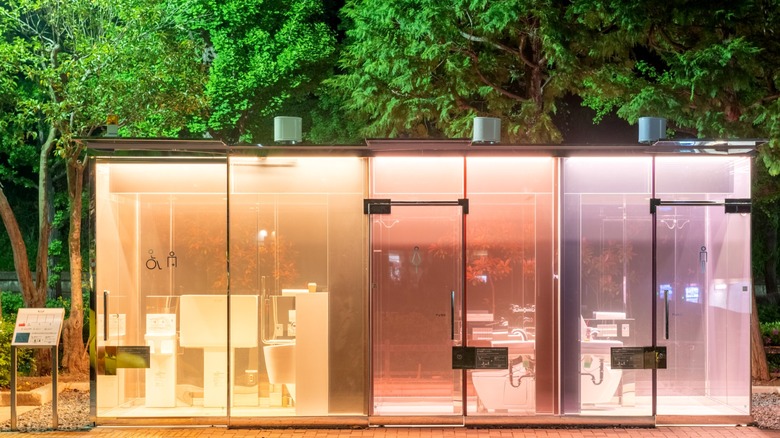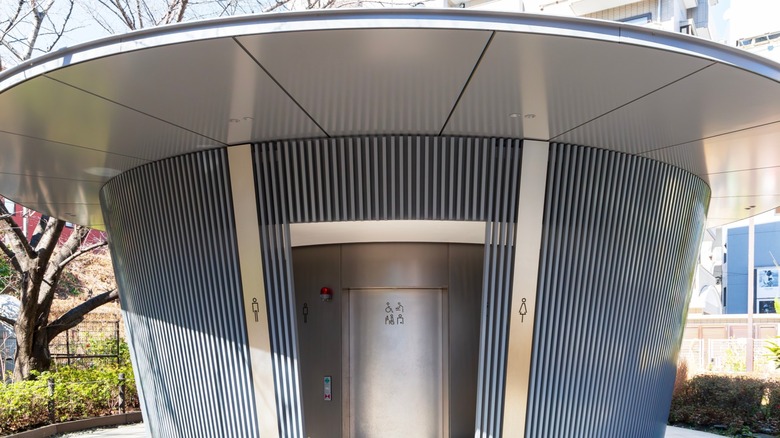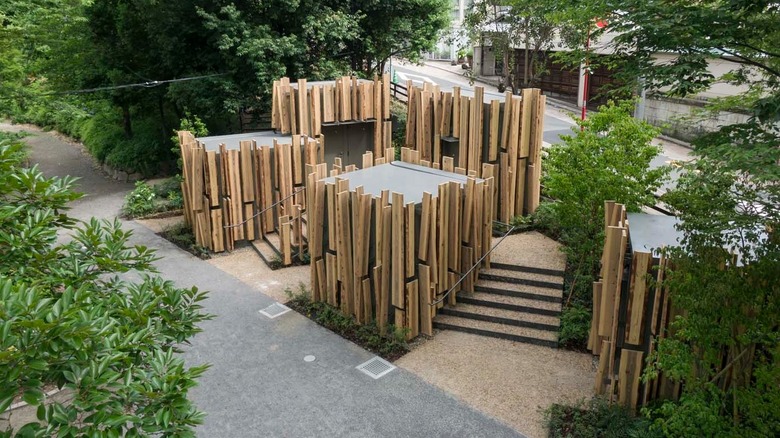Architect-Designed Public Toilets In Tokyo's Trendiest Neighborhood May Be Its Best Tourist Attraction
If you head to Shibuya, one of Tokyo's 23 wards, you'll see an eclectic mix of fashionistas descending upon the many boutiques and malls. Wandering through its streets, you'll discover secret food alleys and Michelin-starred restaurants, along with nightclubs, comedy venues, and themed cocktail bars. This is one of Japan's trendiest areas, known for its animal cafés and thrilling nightlife, as well as being the site of the world's busiest pedestrian crossing. But surprisingly, one of the most interesting attractions might just be Shibuya's public restrooms.
The Tokyo Toilet is a revolutionary project that sought to redesign public toilets, transforming them from a place of perceived filth into an artistic attraction and a beacon of cleanliness. Over six years (from 2018 to 2023), 16 world-renowned architects and designers were invited to replace 17 old public toilets with new, innovative creations, all located in Shibuya. "Public toilets were perceived as pockets of unpleasantness," says Kengo Kuma, one of the architects involved, in a film for the project. "I wanted to turn that notion on its head, where public toilets can elevate the image of an area."
The brainchild of Koji Yanai, heir to the clothing giant that owns Uniqlo, this project was meant to launch during the Tokyo Olympic Games to showcase omotenashi (Japanese hospitality) to the world — but the pandemic delayed these plans. Despite the derailment, the last of the toilets was completed in March 2023 — and it even got a promotional boost from German arthouse director Wim Wenders. He was initially courted to create a series of shorts about the project, but instead, Wenders, a long-time Japanophile, crafted the poetic feature-length "Perfect Days" with screenwriter Takuma Takasaki. All 17 structures feature in this Oscar-nominated movie, which you can see for yourself during your next visit to the city.
The public restrooms of The Tokyo Toilet project
While you may not want to spend your entire vacation hunting down public bathrooms, it is definitely worth your time to check out a few of these unexpected architectural wonders. Simply titled "Toilet," award-winning architect Shigeru Ban's project is a set of modern glass boxes (pictured in the first image). They are colored in translucent candy tones of soft pink, orange, and purple, chosen to match the shades of the nearby playground. Don't be scared off by its transparency — when the door is locked from the inside, the glass becomes opaque. There are three cubicles — female, male, and accessible — in this design. At night, the whole facility is illuminated, a guiding light in the quietly beautiful Yoyogi Fukamachi Mini Park.
Tadao Ando, winner of the Pritzker Architecture Prize (along with Ban), is responsible for "Amayadori" (pictured in the second image), which means "rain shelter" in Japanese. This restroom is nestled inside Jingu-Dori Park under serene cherry trees. The circular block contains an engawa (Japanese porch), and it is surrounded by a wall of metal louvres. The design is aesthetically pleasing but also lets in wind and natural light, creating an open and comfortable space. "We are reminded that beauty and cleanliness go hand in hand," says Ando in the project's film.
Kengo Kuma's "A Walk in the Woods" (pictured in the last image) has been seamlessly integrated into the natural beauty of Nabeshima Shoto Park. Each of the five huts in this facility is designed for a specific user (for example, children or those with accessibility needs). Each one is clad with cedar louvres and connected by a pathway through verdant trees. Like Ando, Kuma wants "to dispel the conventional image of public toilets" with this structure, he tells Dezeen.
Planning your visit to Shibuya, Tokyo
If you are flying into Tokyo, you will almost certainly land at Narita Airport, about 37 miles from the city center (with a smaller number of international flights heading to Haneda Airport). Shibuya is an excellent, centrally-located neighborhood for a home base with a wide variety of accommodations to choose from, including capsules, hostels, luxury hotels, and more. Japan is one of the most expensive countries in the world, so the prices for a stay (even in a compact capsule), particularly in glitzy Shibuya, may come as a shock.
While the city is exceptionally well-organized, with efficient and extensive public transit systems, getting around Tokyo can be intimidating. The many train, bus, and subway lines spread across the city are owned by different companies, meaning that one pass or ticket will not cover them all. The easiest solution is to purchase a prepaid IC card, with the fee for your trip automatically deducted every time you swipe it.
The Tokyo Toilet projects are all in Shibuya but not necessarily close to one another. You can find a map with the locations of the facilities on The Tokyo Toilet's website. To maximize your time, it's best to visit the ones that are on the way or nearby other attractions you're planning to see. Of course, you can view the toilets in any season, but spring is the best time of year to visit Japan, especially if you'd like to see cherry blossoms. While Japan is extremely safe, especially for tourists, popular entertainment districts like Shibuya are among the destinations with the highest amount of pickpocketing in the country. So, just as you would anywhere else, guard your belongings closely and pay attention to your surroundings, particularly when in crowded areas.


